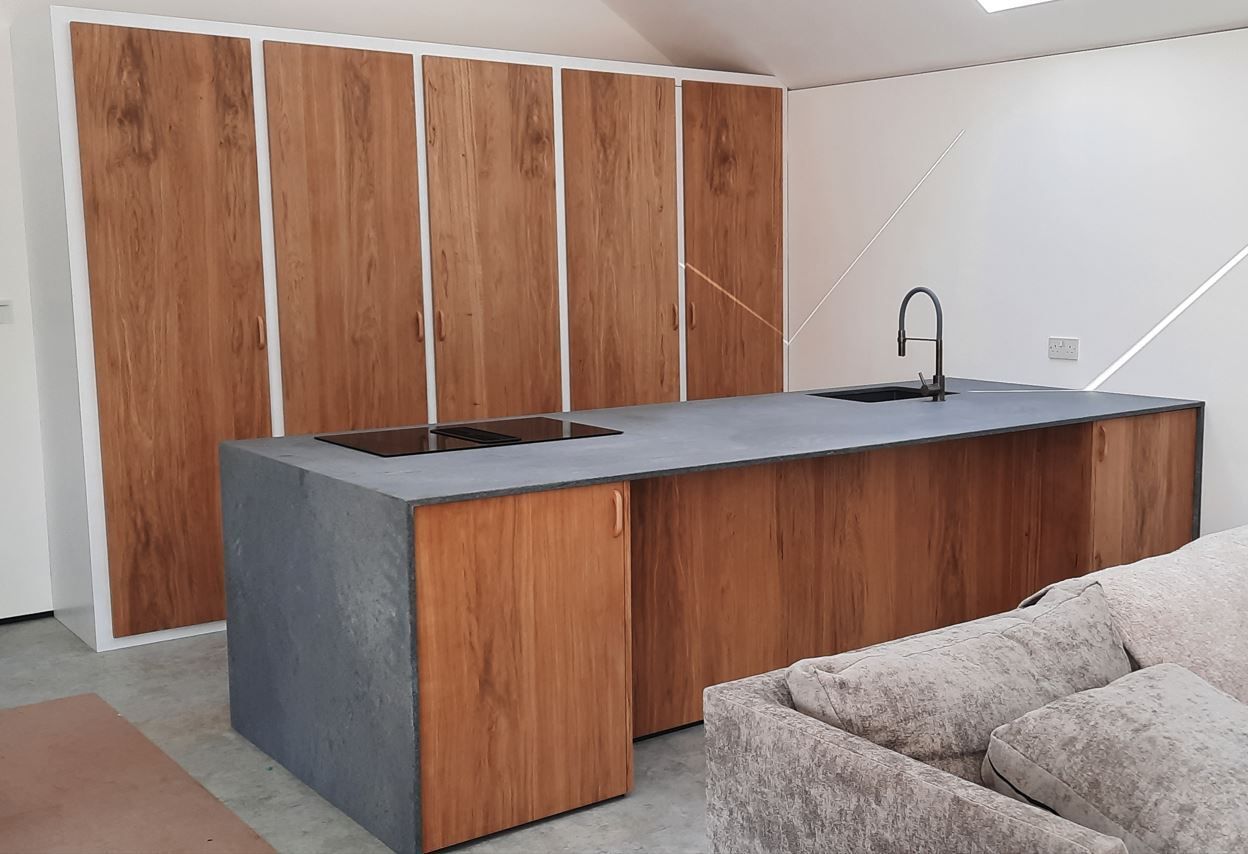
What Is Veneered Plywood?
Veneered plywood consists of a core plywood panel that is covered on both sides with a thin layer of wood veneer on both sides, combining the structural benefits of plywood whilst expanding the decorative possibilities. Common plywood core panels include birch, poplar, rubberwood, and eucalyptus, chosen for their market availability, quality construction and compatibility with veneering processes. Decorative species are not made into plywood panels due to prohibitive costs, log availability or not having the required structural properties. For example, a solid Oak panel would be more expensive than an Oak veneered plywood panel.
Plywood is an engineered wood where the 'plies' of wood are glued together with strong adhesive. The grain direction of each ply is laid crosswise to the layer before it and this criss-cross structure gives plywood remarkable stability and strength.
If using birch plywood, usually the face grades will be BB, meaning no open knots or defects. This results in a stable and solid surface to bond veneer on to.
Alternatives to plywood cores include materials like MDF, chipboard, and blockboard. While these particle boards offer better dimensional stability, they do not have the strength or the multi-layered edge detail that makes plywood a popular choice among designers.
The Different Types Of Veneer
Popular species for veneers include: American White Oak, European Oak, Ash, Cherry, Black Walnut, Maple, Pine, Sapele, Beech and Wenge. Panels are usually cut to size and used in furniture, cabinetry and shopfitting projects. Large full-size panels are suited for wall lining or acoustic panels.
Panel Sizes
Standard sizes are 2440mm x 1220mm (8ft x 4ft) or 3050mm x 1525mm (10ft x 5ft) and cut to size panels are available on request to suit specific project requirements.
Grades Of Veneered Plywood
Grades are specified for both sides: front and reverse.
A/A - High quality A grade on both sides, suitable for applications where both sides are visible.
A/B - A grade face with a lower grade reverse (of the same species). Suitable for when the reverse side is partially visible: inside cupboard doors or underside of shelves.
A/balancer – A grade face with a lower grade reverse (of any species). Suitable for wall lining or uses where the reverse remains unseen. The balancer will be random veneers selected for economic value and will not be suitable for decorative use.
Balancing and Stability
Veneered plywood panels require both sides to be veneered to ensure structural balance and prevent bowing over time. When only one decorative face is needed, a “balancer” veneer is used on the reverse.
Environmental Certification
Opting for environmentally certified wood, such as products endorsed by the Forest Stewardship Council (FSC) or Program for the Endorsement of Forest Certification (PEFC), ensures that the plywood comes from responsibly managed forests. These certifications reflect a commitment to environmental stewardship, biodiversity preservation, and community engagement. We offer FSC and PEFC certified plywood, MDF & chipboard panels.
What Are The Advantages Of Using Veneered Plywood?
Veneered plywood offers several advantages, making it a popular choice in various construction and woodworking applications. Here are some of the key advantages of veneered plywood:
Natural Finish
Unlike melamine or laminates, real wood veneered panels have the character and natural variation that cannot be replicated. The patterns on “wood-effect” panels are repeated and this is especially noticeable on larger projects where many panels are seen together. Whilst laminates and melamine surfaces have developed over the years to closely replicate real wood, it is not possible to replicate the unique one-off character that each individual real-wood veneer panel displays.
Cost-Effective Aesthetics
The appearance of solid wood at a lower cost. This allows for the creation of furniture and surfaces with desirable wood finishes without the high price of solid wood.
Stability and Strength
Plywood is known for its structural stability and strength. The multi-layered construction of plywood results in a strong panel reduces the likelihood of warping or twisting.
Wide Range of Veneer Options
Plywood is produced from relatively few timber species. Therefore, to offer a wider range of colours and wood grain, veneering is required. This provides a very wide range of aesthetic and decorative options and allows designers and architects to achieve specific design preferences.
Versatility
Suitable for a broad range of applications, including furniture construction, cabinetry, panelling, flooring, and more. Veneered plywood can be adapted to different purposes due to its versatility.
Consistency in Appearance
Matched veneers will create a more consistent and uniform appearance than standard plywood could achieve. This uniformity is advantageous for large projects or applications where a cohesive look is desired.
Ease of Workability
Can be easily cut, shaped, and finished, making it convenient to work with. This workability contributes to its popularity in various industries and associated projects.
Standardised Characteristics
As the core material of each panel will be the same (birch plywood, MDF etc) the properties will be consistent. This is of practical useful when considering joists, fixing methods and calculating weight.
Selecting the Right Veneered Plywood
When choosing veneered plywood, consider the species and grade required for your specific project. Each species offers unique characteristics and aesthetics, while the grade will determine the appearance and suitability for different applications.
Please visit the
Specialised Panel Products website for further information or
contact us to discuss any questions or requirements you may have.
